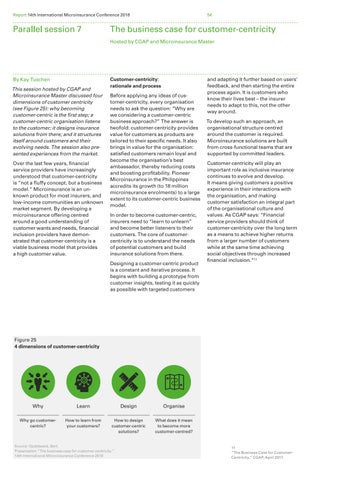Report 14th International Microinsurance Conference 2018
Parallel session 7
54
The business case for customer-centricity Hosted by CGAP and Microinsurance Master
By Kay Tuschen This session hosted by CGAP and Microinsurance Master discussed four dimensions of customer centricity (see Figure 25): why becoming customer-centric is the first step; a customer-centric organisation listens to the customer; it designs insurance solutions from there; and it structures itself around customers and their evolving needs. The session also presented experiences from the market. Over the last few years, financial service providers have increasingly understood that customer-centricity is “not a fluffy concept, but a business model.” Microinsurance is an unknown product for most insurers, and low-income communities an unknown market segment. By developing a microinsurance offering centred around a good understanding of customer wants and needs, financial inclusion providers have demonstrated that customer-centricity is a viable business model that provides a high customer value.
Customer-centricity: rationale and process Before applying any ideas of customer-centricity, every organisation needs to ask the question: “Why are we considering a customer-centric business approach?” The answer is twofold: customer-centricity provides value for customers as products are tailored to their specific needs. It also brings in value for the organisation: satisfied customers remain loyal and become the organisation’s best ambassador, thereby reducing costs and boosting profitability. Pioneer Microinsurance in the Philippines accredits its growth (to 18 million microinsurance enrolments) to a large extent to its customer-centric business model. In order to become customer-centric, insurers need to “learn to unlearn” and become better listeners to their customers. The core of customercentricity is to understand the needs of potential customers and build insurance solutions from there. Designing a customer-centric product is a constant and iterative process. It begins with building a prototype from customer insights, testing it as quickly as possible with targeted customers
and adapting it further based on users’ feedback, and then starting the entire process again. It is customers who know their lives best – the insurer needs to adapt to this, not the other way around. To develop such an approach, an organisational structure centred around the customer is required. Microinsurance solutions are built from cross-functional teams that are supported by committed leaders. Customer-centricity will play an important role as inclusive insurance continues to evolve and develop. It means giving customers a positive experience in their interactions with the organisation, and making customer satisfaction an integral part of the organisational culture and values. As CGAP says: “Financial service providers should think of customer-centricity over the long term as a means to achieve higher returns from a larger number of customers while at the same time achieving social objectives through increased financial inclusion.“11
Figure 25 4 dimensions of customer-centricity
Why
Learn
Design
Organise
Why go customercentric?
How to learn from your customers?
How to design customer-centric solutions?
What does it mean to become more customer-centred?
Source: Opdebeeck, Bert. Presentation “The business case for customer-centricity.” 14th International Microinsurance Conference 2018
11 “The Business Case for CustomerCentricity.” CGAP, April 2017.
